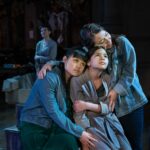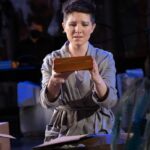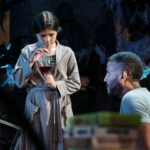APERÇU
| Rôle | Type de voix | Gamme ? | Description du personnage |
|---|---|---|---|
| Sophia | aigu | ||
| Anna | moyen-aigu | Sophia's mother | |
| Wes | moyen-grave | Anna's boyfriend | |
| Emma | aigu | Sophia's sister | |
| Young Sophia | muet-parlé |
Voir plus de vidéos ci-dessous - Cliquez ici
SYNOPSIS
When Sophia’s mother dies, Sophia confronts half-forgotten traumas from her childhood. Sophia and her sister Emma grew up in a war torn country. The two young girls cope with and escape their grim circumstances – the adult world of war, death and displacement – through the lens of fairy tales. As the fighting draws nearer, the family is forced to flee their home and make a dangerous journey into a forest. Sophia’s child’s-view version of their flight includes mystical horrors. As Sophia tries to protect her sister Emma from the evil in the forest, she makes a fatal mistake that forever changes the course of their lives.
Description musicale
Renseignements sur la première
| Rôle | Nom |
|---|---|
| Sophia | Kiera Duffy |
| Rôle | Nom |
|---|---|
| String Quartet | Aizuri Quartet |
| Mise en scène | Brian Staufenbiel |
| Direction musicale | Nicole Paiement |
INFORMATIONS ULTÉRIEURES SUR LA PRODUCTION
| Rôle | Nom |
|---|---|
| Sophia | Maggie Finnegan |
| Anna | Kindra Scharich |
| Wes | Bradley Kynard |
| Emma | Samantha Fung-Lee |
| Emma | Victoria Ko |
| Young Sophia | Charlotte Fanvu |
| Instrumental Ensemble | Del Sol String Quartet |
| Percussion | Divesh Karamchandani |
| Rôle | Nom |
|---|---|
| Chef d'orchestre | Nicole Paiement |
| Mise en scène | Brian Staufenbiel |
| Assistant(e) à la direction musicale | Jessica Bejarano |
| Conception scénique | Jon Altemus |
| Conception de l'éclairage | Aaron Curry |
| Conception des costumes | Marisely Cortés Fonseca |
Casting:
| Rôle | Nom |
|---|---|
| Sophia | Elena Howard-Scott |
| Anna | Adanya Dunn |
| Wes | Luka Kawabata |
| Emma | Audrey Gao |
| Young Sophia | Arya Yazgan |
| Rôle | Nom |
|---|---|
| Mise en scène | Julie McIsaac |
| Direction musicale | Gordon Gerrard |
| Violon I | Rebecca Whitling |
| Violon II | Karen Gerbrecht |
| Alto | Isabelle Roland |
| Violoncelle | Olivia Blander |
| Percussion | Mischa Gerbrecht |
| Midi-Controlled Sculptures | Lembit Beecher |
| Concepteur de production | Wladimiro A. Woyno R. |
| Associate Production Designer | Hailey Gil |
| Associate Set Designer | Megan Lane |
| Associate Lighting Designer | Hannah Azam |
| Conception des costumes | Alaia Hamer |
| Sound designer & Production Manager | Richard Berg |
| Régie technique | Emma Hammond |
| Assistant(e) à la régie technique | Maddy Woodley |
| Pianiste de répétition | Frances Armstrong |
| Intimacy Director | Lisa Goebel |
CRÉATION
Déclaration de l'équipe artistique
Librettist's Note
In 1908, my Romanian great-grandparents, Chaya Yankovitch and Chaim Moscovitch, left Bucharest and travelled across the ocean to Halifax, Canada. They left because Eastern European Jews were being massacred in a vicious wave of pogroms. In Canada, my great-grandparents thrived. They had children who had children who live today. The branch of my family that remained in Romania, however, all died. For my family, one journey marks the border between life and death. That journey is imprinted on my psyche and over the years it has taken on a mystical quality in my mind. Sophia’s Forest is an expression of that mysticism.
Eastern Europe and in particular the Balkans continue to be roiled by genocide and war right up and into the present day. I’ve used details and circumstances lifted from contemporary conflicts in the Ukraine, Chechnya, Bosnia and Herzegovina, Kosovo, and Serbia to create the world of Sophia’s Forest.
– Hannah Moscovitch
Composer's Note
I grew up with stories about Estonia: my grandmother was born there in 1922 and her stories described how she survived both the Soviet and Nazi occupations of Estonia and immigrated to the United States as a single mother of two. These stories were intense and dramatic, and in repeated retellings acquired the sheen of legend. More recently I found a picture of my mother in a displaced persons camp in Germany after WWII. She was 7, with a group of children all looking intensely at the camera, clutching teddy bears. The family story suddenly seemed more real. I began to think about the experience of immigration for children, and the role of imagination and play in dealing with traumatic circumstances, thoughts which were compounded by the recent images of Syrian and African refugees so prominent in the news. This piece is not my mother or grandmother’s story in any way, but as was the case with Hannah, I think family history drew me towards this topic.
The sound sculptures in the piece grew out of my desire to find a way to represent sonically the inner world of the protagonist, nine-year-old Sophia. The sounds the sculptures make, with wine glasses and bike wheels, have clear literal associations deriving from specific memories of Sophia, but these sounds can be re-interpreted: it is amazing how easily a wine glass can sound like a young girl’s singing voice or the windshield wipers of a car. And I can imagine how the sounds of a whirring bike wheel could call to the mind of a young child the fluttering wings of a goblin. Developing this piece has been a true collaborative process, between singers, instrumentalists, engineers, architects, librettist and director; I’m so thankful for the countless hours that have been spent by others working on this project with me.
– Lembit Beecher
CITATIONS DES MÉDIAS
“Not to be overlooked…is Sophia’s Forest…I missed it but caught up with a video that verified much of the rapturous reaction I’d heard from others. A searingly introspective study on immigrant children, the opera was full of vocal lines reflecting psychological depths but also electronic music effects that added greatly to the dreamlike atmosphere. The superb soprano Kiera Duffy was a major plus in the leading role.”
– David Patrick Stearns, Philadelphia Inquirer
"The rest of the fine, understated score—atmospheric and sensitively deployed in terms of pacing the sung and spoken material—emerged from elaborately worked musical sculptural “tree” units that Beecher controlled from a computer, seated with the musicians at the rear of the playing space."
– David Shengold, Opera News
VIDÉOS
PRODUCTION VIDEOS
Il n'y a pas encore de critiques. Soyez le premier à en écrire un.
REVOIR CET OPÉRA
Vous devez être connecté pour soumettre un avis.
Soumettre une suggestion
Veuillez noter : comme nous faisons de notre mieux pour garantir que toutes les données de cette page sont correctes, veuillez comprendre que ces pages ont été créées par des humains, nous sommes donc voués à commettre des erreurs. Faites-nous savoir si vous avez trouvé des erreurs, des fautes de frappe ou des fautes sur cette page. Si vous avez des suggestions sur l'ajout de balises à cette page, veuillez également utiliser ce lien de courrier électronique. Merci, votre aide et votre contribution sont appréciées.








